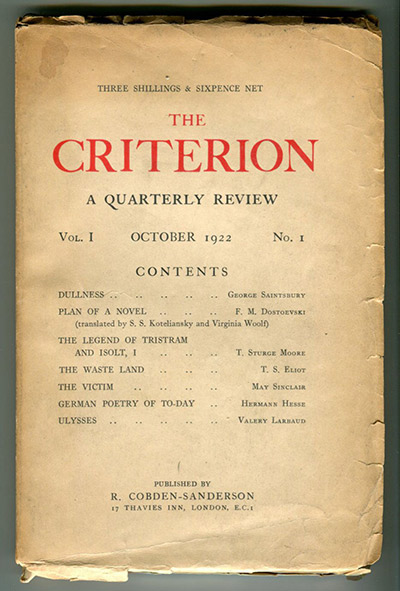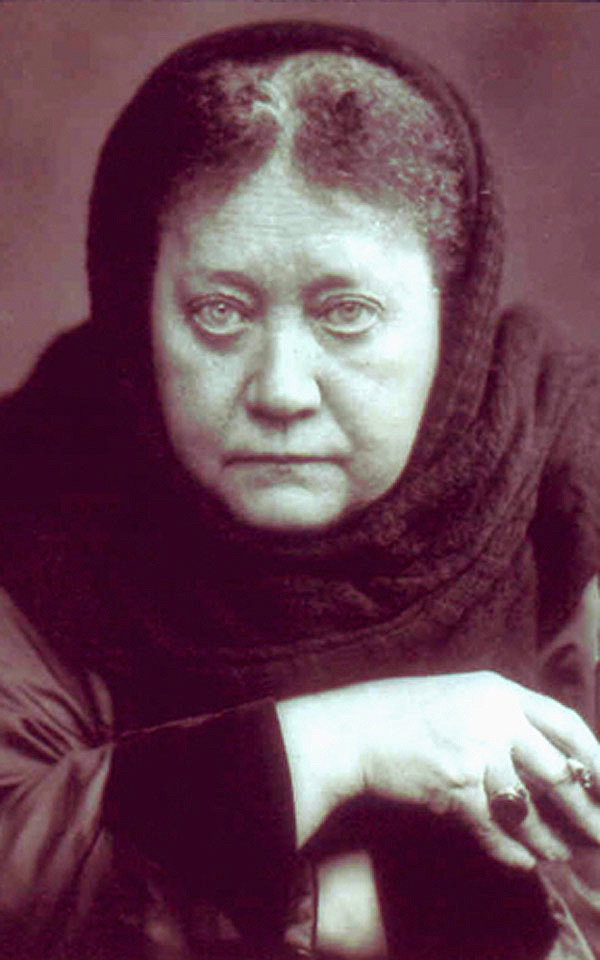wcag heading
Gamache took the bread to the long pine table, set for dinner, then returned to the living room. He reflected on T.S. Eliot and thought the poet had called April the cruelest month not because it killed flowers and buds on the trees, but because sometimes it didn’t. How difficult it was for those who didn’t bloom when all about was new life and hope. (The Cruelest Month, page 248, Trade Paperback Edition)
How serendipitous to offer this post up in the month of April when the novel itself is set and the month—by way of T.S. Eliot’s The Waste Land—that has provided one of the most recognizable lines in modernist poetry.
 Originally published in The Criterion in 1922, The Waste Land was conceived by Eliot during what has come to have been described as a nervous breakdown and was heavily influenced by many things, including the Grail Legend, the work of James Joyce, Homer, and Hermann Hesse. The poem defines the prevailing desperation of the post-World War I generation as well as Eliot’s own tortured time.
Originally published in The Criterion in 1922, The Waste Land was conceived by Eliot during what has come to have been described as a nervous breakdown and was heavily influenced by many things, including the Grail Legend, the work of James Joyce, Homer, and Hermann Hesse. The poem defines the prevailing desperation of the post-World War I generation as well as Eliot’s own tortured time.
Eliot described his epic poem as, “the relief of a personal and wholly insignificant grouse against life . . . just a piece of rhythmical grumbling.” Despite the poet’s own downplaying of his work, a vast number of significant critics disagreed with him. Conrad Aiken called it, “One of the most moving and original poems of our time” while Ezra Pound— who had a heavy hand in editing Eliot’s masterpiece—called it a “justification” of “our modern experiment”.
At its heart, The Waste Land is about rebirth—the revitalization of society after the catastrophes of war, the restoration of the mind after the ravages of mental illness, and the reinvigoration of the spirit after prolonged dejection.
 Louise, as always, has chosen the perfect title because at the very core of this magnificent novel is the notion of rebirth and as the Gamache quote (at the top of page)—and Eliot’s own “April is the cruelest month” line—so profoundly illustrate is that rebirth can be accompanied by astonishing pain, even death.
Louise, as always, has chosen the perfect title because at the very core of this magnificent novel is the notion of rebirth and as the Gamache quote (at the top of page)—and Eliot’s own “April is the cruelest month” line—so profoundly illustrate is that rebirth can be accompanied by astonishing pain, even death.
We witness this throughout the book from the reoccurring theme of Easter (the death and rebirth of Christ), the rebirth of flora and fauna when winter turns to spring, Ruth and the ducklings Rosa and Lillium, to the séance itself (the living communicating with the dead).
In closing, I can’t help but point out one of the great “wink and nods” from the novel that concretely connects T.S. Eliot to Louise’s tome and that is Jeanne Chauvet using the nom de plume “Madame Blavatsky”.
The real Blavatsky, an infamous occultist of the late 19th Century, was heavily referenced in Eliot’s 1919 poem, The Cooking Egg:
Madame Blavatsky will instruct me
And, like Blavatsky, Chauvet offers her own guidance throughout The Cruelest Month.


45 replies on “CULTURAL INSPIRATIONS FROM THREE PINES: THE CRUELEST MONTH”
I am re-reading the books after initial reading and re-reading years ago. As noted above, they are a pure delight a third time round.
I studied Eliot over 50 years ago and was too young to really ‘get’ him. Such a joy to finally make connections.
Please let me know if the careless and intentional killing of the Cree youth really happened. The news never reached Australia.
Looking forward to the next episode of the lives of Gamache and Three Pines,
Vicki White
I am wondering if I missed something in ” the Cruelest Month”. Did not understand why Gamache’s friend Michel Brebeuf was in the Hadley house for final reveal of murderer?
[…] Abroad,” we visit the Norwegian edition of The Cruelest Month. As you might remember from the Cultural Inspirations we did about this book, the title directly references the T.S. Eliot poem “The Wasteland.” In […]
[…] Abroad,” we visit the Norwegian edition of The Cruelest Month. As you might remember from the Cultural Inspirations we did about this book, the title directly references the T.S. Eliot poem “The Wasteland.” In […]
So is it “cruellest or cruelest?
Depends on whether you are north or south of the 49th parallel
It ‘s ‘cruellest’ if you’re British, ‘cruelest’ if you’re from the USA.
“What we call the beginning is often the end
And to make and end is to make a beginning.
The end is where we start from.”
Eliot is so perfect when reading this series.
I’m midway through The Cruelest Month and a newcomer to Penny and midway…where has she been all my life?
Savoring every word….
I am puzzled by how the investigating team can eat all those luscious Bistro and bakery meals (complete with alcohol and rich desserts) and there is no mentioning of the need for elastic waste bands or serious bouts of exercise.
Paul, I would suggest too that another significant symbol of rebirth brings the story to a close with the clean-up and restoring the life of the house which had already been declared dead and fit only to have the remains removed.
Indeed, Ileen. Thanks!
The Wasteland is one of my favorite poems, but I had forgotten. Time to read that again. Thank you for tying all of this together! I did catch the Madame Blavatsky reference. So much to read!!
I am on my 12th and I bought the audio for each one. My primary language is Spanish, so I carry my phone when I read or listen, because I occasionally need a translation from English or French to Spanish. I love every one of her books and I am enjoying them immensely. It’s hard to choose a favorite, but I just listened to “How the light gets in” again during my “garden time” and I fell in love with this book again. So detailed , I transport myself into “Three Pine” with all these people (Gabry, Ruth, Gamache, Jean-Guy, Rosa etc, the food, the landscape. Please Miss Penny, DO NOT KILL OFF anymore characters, I’m begging you. I love everyone of them…. 🙂
After our Easter service last Sunday, our pastor and I were talking about the many horrific things that have happened in April…assassinations being the worst, and I mentioned that he and I were not the first to note April’s cruelty….he looked puzzled. I just said Eliot and he lit up in acknowledgement.
I am so enjoying these “Cultural Inspirations” as they deepen the characters and plots. I have reordered many in the series to reread. I always pass Louise Penny’s books on to my daughters.
The “Inspirations” are a an added treat, each book is a treat! Thank you Louise Penny!
I had just requested the book from the library even forgetting that it was about April. I have always liked April as it is my birthday month but I have a new respect for it now. These books are magnificent and I am working my way through them for the second time.
One of the first things I learned from my husband who works in suicide prevention is that suicide goes up in the spring, for the very reason so beautifully expressed in the quote, “April, the cruelest month not because it killed flowers and buds on the trees, but because sometimes it didn’t. How difficult it was for those who didn’t bloom when all about was new life and hope.”
Time to do something with ‘Little Gidding’ from Eliot’s “Four Quartets.”
I am so enjoying this forum. Your books are so deep and profound. I must start rereading them.
Thanks for a great discussion. I have loved that title and its source—so perfect for the story. Louise Penny’s books are so much more than mysteries. Reading them twice is a necessity, just to really “get” everything. The third reading, somewhat later, is pure pleasure.
What a wonderful way to see and understand all of the literary references in her books.
Louise ….your novels make your readers think, feel. And some feel connected with the characters and some strange way to the story you beautifully weave .
Thank you for all of this.
I also really like these lines from The Wasteland and think they are at the heart of so much of literature and life, and very much at the heart of fine detective fiction such as Louise Penny’s. What are the consequences of a moment’s surrender, and what is the detective’s role in restoring order after the surrender that can’t be retracted has occurred?
“The awful daring of a moment’s surrender
Which an age of prudence can never retract”